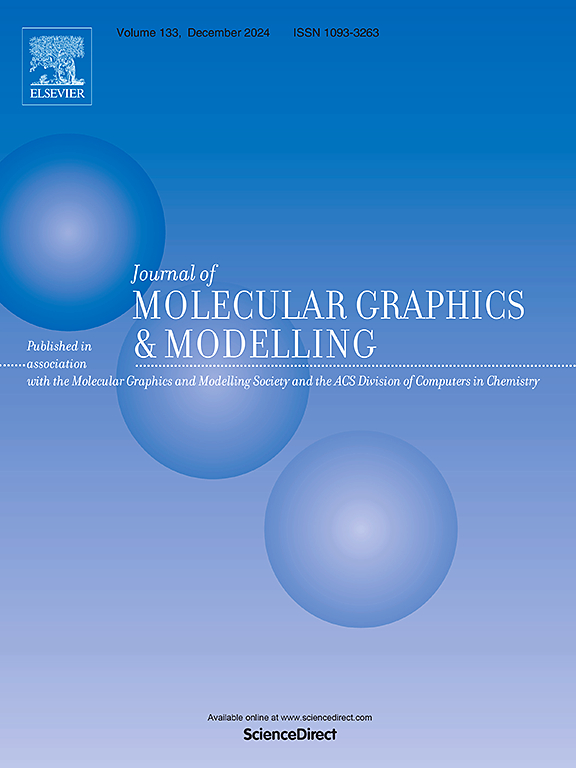Exploring structures, bonding, energetics and interactions of aqua complexes of actinide ions at various oxidation states using density functional theory
IF 2.7
4区 生物学
Q2 BIOCHEMICAL RESEARCH METHODS
引用次数: 0
Abstract
A systematic study of interactions of U, Np and Pu ions with water in their all possible oxidation states (OSs) has been performed using DFT with triple zeta basis sets, hybrid functional and D3 dispersion correction. In gaseous phase, the maximum coordination of 9 water molecules is observed for U in both +3 and + 4 OSs and Np in +4 OS, whereas the same of 10 water molecules is obtained in +3 OS of Np and both +3 and + 4 OSs of Pu. However, in +5 and + 6 OSs, the actinide oxy ions are solvated by maximum 5 water molecules for all the three actinides, whereas in +7 state of both Np and Pu, there are 4 water molecules. Application of COSMO solvation model, although changes binding energy significantly, but does not change the maximum coordination number of all the complexes except for Np4+, in which the maximum coordination number changes from 9 to 10. However, the most favourable coordination number calculated using step-wise hydration energy in cases of complexes in gaseous phase and COSMO bulk phase is quite different. The calculated negative binding energies with the non-negative vibrational frequencies of the optimized complexes signify true minimum energy structures. The stretching frequencies of the actinide-oxygen (Ac=O) double bonds decrease whereas those of water O-H bonds (of water ligand) increase as the number of water molecules in the first solvation shell of the ions increases. One of the major highlights of the present investigation is the use of non-covalent interaction (NCI) and reduced density gradient (RDG) methods to reveal the importance of small but significant weak interactions like van der Waals, dipole-dipole and steric repulsion in stabilizing these complexes. Present study provides a comprehensive systematic analysis of structure, bonding, energetics and interaction of aqua complexes of three actinides in their all available oxidation states by treating all these complexes at the same level of theory.

利用密度泛函理论探索不同氧化态下锕系离子水合物的结构、键合、能量学和相互作用
利用三zeta基集、杂化泛函和D3色散校正的DFT,系统地研究了U、Np和Pu离子在所有可能的氧化态(OSs)下与水的相互作用。在气相中,U在+3和+4 OS中有9个水分子的最大配位,Np在+4 OS中有9个水分子的最大配位,而Np在+3 OS中有10个水分子的最大配位,Pu在+3和+4 OS中有10个水分子的最大配位。然而,在+5和+ 6 os中,三种锕系元素的氧离子都被最多5个水分子溶剂化,而在Np和Pu的+7状态下,都有4个水分子。COSMO溶剂化模型的应用,虽然能明显改变配合物的结合能,但除了Np4+的最大配位数由9变为10外,其余配合物的最大配位数均未发生变化。然而,在气相和COSMO体相的配合物中,用逐级水化能计算出的最有利配位数是完全不同的。优化后的配合物具有非负振动频率的负结合能表示真正的最小能量结构。锕系-氧(Ac=O)双键的拉伸频率随着离子第一溶剂化层中水分子数量的增加而降低,而水O- h键(水配体)的拉伸频率则增加。本研究的主要亮点之一是使用非共价相互作用(NCI)和减少密度梯度(RDG)方法来揭示小而重要的弱相互作用,如范德华,偶极子-偶极子和空间排斥在稳定这些配合物中的重要性。本研究对三种锕系元素的水络合物的结构、键合、能量学和相互作用进行了全面系统的分析,并在同一理论水平上对它们进行了处理。
本文章由计算机程序翻译,如有差异,请以英文原文为准。
求助全文
约1分钟内获得全文
求助全文
来源期刊

Journal of molecular graphics & modelling
生物-计算机:跨学科应用
CiteScore
5.50
自引率
6.90%
发文量
216
审稿时长
35 days
期刊介绍:
The Journal of Molecular Graphics and Modelling is devoted to the publication of papers on the uses of computers in theoretical investigations of molecular structure, function, interaction, and design. The scope of the journal includes all aspects of molecular modeling and computational chemistry, including, for instance, the study of molecular shape and properties, molecular simulations, protein and polymer engineering, drug design, materials design, structure-activity and structure-property relationships, database mining, and compound library design.
As a primary research journal, JMGM seeks to bring new knowledge to the attention of our readers. As such, submissions to the journal need to not only report results, but must draw conclusions and explore implications of the work presented. Authors are strongly encouraged to bear this in mind when preparing manuscripts. Routine applications of standard modelling approaches, providing only very limited new scientific insight, will not meet our criteria for publication. Reproducibility of reported calculations is an important issue. Wherever possible, we urge authors to enhance their papers with Supplementary Data, for example, in QSAR studies machine-readable versions of molecular datasets or in the development of new force-field parameters versions of the topology and force field parameter files. Routine applications of existing methods that do not lead to genuinely new insight will not be considered.
 求助内容:
求助内容: 应助结果提醒方式:
应助结果提醒方式:


